|
Have a safe day!
Thursday, June 21
3:30 p.m.
DIRECTOR'S COFFEE BREAK -
2nd Flr X-Over
4 p.m.
Accelerator Physics and Technology Seminar (NOTE LOCATION) - Curia II
Speaker: Ian Pong, ITER
Title: From Nb, Ti and Sn to NbTi and Ti-doped Nb3Sn, from Raw Material to Full-Size Conductor
THERE WILL BE NO THEORETICAL PHYSICS SEMINAR THIS WEEK
Friday, June 22
3:30 p.m.
DIRECTOR'S COFFEE BREAK - 2nd Flr X-Over
4 p.m.
Joint Experiment-Theoretical Physics Seminar - One West
Speaker: Robert Tschirhart, Fermilab
Title: Project X Physics Study: Summary and Outlook
Click here for NALCAL,
a weekly calendar with links to additional information.
Upcoming conferences |
| Thursday, June 21
- Breakfast: Apple sticks
- Minnesota wild rice w/ chicken
- Tuna melt on nine-grain bread
- Smart cuisine: Italian meatloaf
- Chicken casserole
- Buffalo crispy-chicken wrap
- Assorted sliced pizza
- Smart cuisine: Mandarin chicken salad
Wilson Hall Cafe Menu |
|
Friday, June 22
Dinner
Closed
Wednesday, June 27
Lunch
- Spring-roll salad w/ red-curry shrimp
- Lemon Napoleon
Chez Leon Menu
Call x3524 to make your reservation.
|
|
Fermilab Today reader survey closes tomorrow
Fermilab Today would like to thank everyone who has participated in the reader survey. The number of responses has been significant, but there are still more of you we'd like to hear from.
The survey closes tomorrow, June 22. Both Fermilab employees and subscribers outside the laboratory will receive one last reminder today from today@fnal.gov. The link in the e-mail will be a Fermilab URL but will redirect you to the actual survey page, hosted by snapsurveys.com.
Please complete the questionnaire if you have not yet done so. If you have, thanks again for your input!
|
University of Chicago
NAME:
University of Chicago
HOME TOWN:
Chicago, Illinois
MASCOT:
Phoenix
SCHOOL COLOR:
Maroon
PARTICLE PHYSICS COLLABORATIONS:
CDF, LBNE, MINERvA
Also participates in ATLAS (CERN), Double Chooz (IN2P3), E14 (JPARC)
NUMBER OF SCIENTISTS AND STUDENTS AT FERMILAB:
15 faculty, 15 postdocs, 25 graduate students
COLLABORATING AT FERMILAB SINCE:
Early 1970s
PARTICLE PHYSICS RESEARCH FOCUS:
Collider physics, neutrino physics, CP violation in K systems, Higgs physics, supersymmetry, string theory, heavy quark physics, physics beyond the Standard Model,
cosmic-ray physics, dark matter
WHAT SETS PARTICLE PHYSICS AT THE UNIVERSITY OF CHICAGO APART?
We enjoy the interaction among disciplines encouraged by the Enrico Fermi Institute structure that encompasses HEP, particle theory, cosmology, relativity, astrophysics, astronomy and the Kavli Institute for Cosmological Physics. Our proximity to Argonne and Fermilab also encourages more direct participation in a broad range of research and technology. Our electronics development group has expertise in state-of-the-art electronics and is a wonderful training ground for students. Our Computation Institute maintains ATLAS Tier-2 and -3 centers and is engaged in advances in grid computing.
FUNDING AGENCIES:
DOE, NSF
View all university profiles.
|
Local volunteers invited to participate in quadrat study
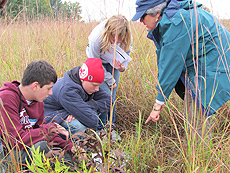 |
| A docent guides students in a quadrat study in the Fermilab prairie. Photo: Diane Hinck |
For the past 20 years, Fermilab's Education Office docents have taken school groups into the Fermilab prairie as a way for kids to learn about their local environment and to help keep track of plant species in Fermilab's restored prairies. Over the past seven years, volunteers from the local community have also participated in these studies.
Starting on June 26, docents will take one such group of volunteers to a plot near Lederman Science Center to do a quadrat study, the same sort of activity the schoolchildren would do. The study involves framing a 1-by-1 square-meter area of land and identifying and counting every species found inside it. Groups of four volunteers will handle at most two frames each, and the frames will be used to make a grid for a map showing species distribution.
"In doing these counts, they become our citizen scientists," said Sue Sheehan of the Education Office. "The big goal is to give people who are interested the opportunity to do field work."
The data from the quadrat studies goes online in a public database. Local teachers often use the data as a classroom tool. Sheehan also hopes these data will help people have a stake in their environment.
"We're enticing them to become stewards of the prairie," Sheehan said.
Once the data are available online, volunteers can track changes in the landscape from year to year. Sometimes the quadrat studies have revealed major changes in the prairie. Sheehan recalled the time when volunteers found a single instance of a plant called rattlesnake master.
Read more
—Joseph Piergrossi
|
Tevatron tour at Fermilab
From Naperville Community Television Channel 17, June 15, 2012
Scientists from across the world gathered at nearby Fermilab to celebrate the impact of the Tevatron. Attendees kicked off a daylong symposium with a close up look at the historic particle accelerator.
Watch the newscast
|
New data on elusive particle shrouded in secrecy
From The New York Times, June 19, 2012
Dr. Higgs, I presume?
A team of physicists gathered in a room at CERN on Friday to begin crunching new data from the Large Hadron Collider this year. And they will be at it all week.
What they are seeing nobody knows.
What they are looking for is the beginning to the end of the longest and most expensive manhunt in the history of physics, one that has involved several generations of larger and larger particle accelerators: the spoor of a hypothetical particle that endows other elementary particles with mass.
Read more
|
|
When protons strike a glancing blow
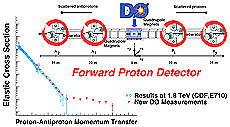 |
| The Forward Proton Detector measured protons and antiprotons that scattered at extremely small angles with respect to the beam.
|
Not every interaction between a proton and antiproton at the Tevatron was a head-on collision. Some collisions would break apart one or both of the particles, perhaps creating rare forms of matter like top quarks or possibly Higgs bosons. However, elastic collisions did often occur. In these, both the proton and antiproton are left intact and no additional particles are created. The interaction rate of these glancing blows between a proton and antiproton cannot easily be calculated in the Standard Model. Experimental measurements of these interactions place important constraints on the models used to describe elastic collisions.
After an elastic collision at the Tevatron, the proton and antiproton would continue to travel nearly parallel to their own proton or antiproton beam. The scattered particles would leave the DZero collision hall while still within the beam pipe that bores through the middle of the detector, invisible to the active readout elements. To detect elastic collisions,the DZero collaboration installed special detector arrays within the beam pipe surrounding the DZero interaction point at four locations, at 23 and 31 meters in either direction down the beam line. During data taking, the elements of the Forward Proton Detector were inserted to within a few millimeters of the beam in order to detect elastically scattered protons and antiprotons.
Analyzers used the Forward Proton Detector to study the rate of elastic collisions between protons and antiprotons. The data used in this analysis were collected with dedicated Tevatron beam conditions, where only a single proton bunch and a single antiproton bunch were injected into the accelerator and brought into collision. This analysis extended measurements of the proton-antiproton elastic cross section to higher momentum transfers than ever before at the full Tevatron collision energy. The results also demonstrate a significant change in elastic collision rate past a certain amount of momentum transfer, consistent with the expectations from elastic collision models.
—Mike Cooke
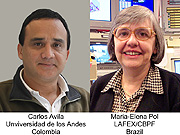 |
| These physicists made major contributions to this analysis.
|
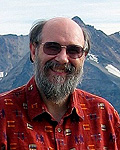 |
| As the databases coordinator, Jim Linnemann (Michigan State University) works with the Fermilab Computing Sector to maintain and ensure reliable access to information vital to the success of the DZero experiment, from detector calibration, trigger and luminosity data to slides and proceedings from conference presentations. |
|
$27 million award bolsters research computing grid
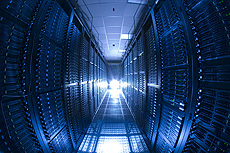 |
| Fermilab's Grid Computing Center. Fermilab is an active member of the Open Science Grid, a community alliance in which universities, national laboratories, scientific collaborations and software developers contribute computing and data storage resources, software and technologies. Photo: Reidar Hahn |
June 20, 2012 — Every day researchers add another sea of data to an ocean of knowledge on the world around us — billions on top of billions of measurements, images and observations of the tiniest subatomic particles up to the movement of planets and stars.
"Making sense of that — simulating, mapping, analyzing — this is how researchers work these days," said Miron Livny, computer sciences professor at the University of Wisconsin–Madison. "More and more researchers need more and more computing power to support that work."
To that end, the Department of Energy Office of Science and the National Science Foundation have committed up to $27 million to Open Science Grid (OSG), a nine-member partnership extending the reach of distributed high-throughput computing (DHTC) capabilities.
Distributed computing musters the power of a network of machines that reside at different institutions to make the best use of all available processing and storage capacity, giving scientists the muscle of a supercomputer that may otherwise be out of reach.
Expanded over the last six years to include more than 80 sites contributing users and data storage and processing capacity, OSG now delivers more than 2 million computing hours and moves about a third of a petabyte of data on a daily basis.
Read more
|
|